|
|
|
 |
|
"MAY THE LORD BLESS YOU AND KEEP YOU. MAY
THE LORD CAUSE
HIS COUNTENANCE TO SHINE UPON YOU AND BE GRACIOUS
UNTO YOU.
MAY THE LORD LIFT HIS COUNTENANCE TOWARD YOU AND
GRANT YOU PEACE"
NUMBERS 6: 24-26
|
|

|
 |
The priestly benediction bestowed by Aaron
and his sons upon the children of Israel,
recorded in Numbers chapter 6, verses 24
through 26, is still recited to this very
day on occasions ranging from the inauguration
of the U.S. President in Washington D.C.,
to an assembly of tens of thousands of pilgrims
gathered before the Western Wall in Jerusalem,
during the Feasts of Passover and Tabernacles.
Imagine, then, the excitement when the oldest
biblical texts ever discovered – from the
seventh century B.C. (that’s 2700 years
ago) – revealed the Hebrew words of the
Priestly Benediction originally recited
by Aaron and his sons. |
| |
|

|
|
Photo:
Gila Yudkin
|
|
Thousands of priests (cohanim)
reciting the Priestly Benediction
by the Western Wall during the feast of
Passover
|
| |
|
The discovery of biblical texts incised
on silver amulets was made in 1979, by the
Scottish Church of St. Andrew in Jerusalem,
during an excavation headed by Gabriel Barkay,
on behalf of Tel Aviv University.
Today, immediately below the Scottish church,
it is now possible to view the burial cave
complex where the Priestly Benediction was
found. A walkway leading to the rock-cut
tombs is part of a new center dedicated
to the legacy of Israeli Prime Minister
Menachem Begin. |
| |
|

|
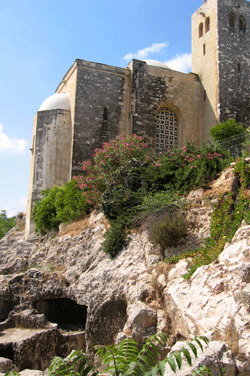
|
|
Photo:
Gila Yudkin
|
Photo:
Gila Yudkin
|
|
Pilgrims gather by the
Western Wall
|
Burial Tombs by the Church
of St. Andrew
|
|
to be blessed by the priests
(cohanim)
|
where the 7th c. BC amulets
were found
|
| |
|
“It’s the most important find of my life,”
says Gaby, who is presently in charge of
the sifting of ancient material illicitly
carted off in the course of the building
of a mosque on the Temple Mount and dumped
in the Kidron Valley. “It’s something
that you find very rarely.” |
| |
For this “Holy Sites – Gila’s Highlights,”
I met with Gaby at his Jerusalem home, just
two miles south of where the silver amulets
were found, and asked him to describe the
discovery of the Priestly Benediction for
readers of “Pilgrimage Panorama.”
Here is Dr. Gaby Barkay’s account.
“In the 1970’s I was interested in extra-mural
activity, that is, activity outside the
walls of the city. There would be
quarrying of stones outside the city, growing
fresh vegetables, military gatherings, burials,
roads and military watch towers. These
would have occupied a place not too far
from the city, but not too close.
“I put myself in the shoes of the ancients
and thought to myself, where would those
functions have taken place? I decided
that the hill [Ketef Hinnom] where St Andrews
was located was the best probability.
I took a survey and collected pottery and
was convinced that there were finds to be
made there.
“With a little donation in 1975, I did a
modest exploration and found remnants from
an ancient Christian church and a burial
grave. It was enough to prove that
it was a worthwhile location.
“In 1979 to 1980, I came back with a limited
budget under the sponsorship of Tel Aviv
University. The ‘volunteers’ were
12- to 13-year-olds from Tel Aviv, members
of an archeology club for youth organized
by the Society for the Protection of Nature
in Israel. Thirteen is a dangerous
age. But the S.P.N.I. provided the
money – it was a low budget -- I was happy
to have them nevertheless.
“We excavated by the outer apse of the present
day church. The graves were in bad
shape with collapsed roofs. The caves
had all been looted. On top of the
caves was a road connecting Jerusalem with
Bethlehem.
“One cave had a series of headrests and
burial benches. One bench was shaped
like a cushion with six head rests.
One bead was found that had been part of
the burial gifts. Under the bench,
we discovered a repository where they buried
the bones and I looked into that repository
and saw something that looked like a rock
floor. I was disappointed. |
| |
|

|
|
Photo:
Gila Yudkin
|
|
One burial bench with
six head rests shaped like cushions
|
| |
“Among the thirteen-year-old diggers, there
was one annoying kid named Nathan, who was
always tugging at my shirt. I thought
this was an ideal place to put him – he
would be out of my sight. I told Nathan
the repository had to be as clean as his
mother’s kitchen, even if he had to lick
it. It had to be clean for the photography.
“Not too long afterwards, I felt him tugging
at my shirt again. Nathan had in his
hand almost complete pottery vessels.
This time, I pulled at his shirt, took him
back to the area and asked where he found
them. Bored, Nathan had banged on
the floor with a hammer. Under the
rocks, he found the pottery.
“Little Nathan was sent home with his peers.
Then I recruited archeology students from
Tel Aviv and Jerusalem and from the Institute
for Holy Land Studies on Mount Zion.
The pastor at St Andrew, who was a student
of mine, brought us electricity from the
church. We worked 24 hours around
the clock. |
| |
|
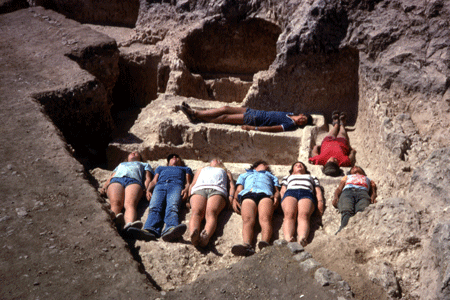
|
|
Courtesy of Gordon
Franz
|
|
Volunteer excavators
illustrating the burial benches
in Ketef Hinnom
|
| |
“In one chamber more than a thousand
objects were found. They included
125 objects of silver, 40 iron arrowheads,
gold, ivory, glass, bone and 150
semi-precious stones. There
was 60 centimeters [two feet] of
accumulation filled with objects
and skeletal remains. There
was a lot of dust and a lack of
oxygen.
“It was very hot. We had to
change teams every few hours.
There was a lady who was in charge
of coffee and sandwiches.
Everyone was sworn to secrecy –
they weren’t allowed to tell parents,
spouses, or friends. If word
got around Jerusalem that there
was such a treasure, the California
gold rush would be nothing compared
to what would happen here. |
| |
|

|
“Judy
Hadley, a girl from Toledo Ohio,
now a professor of Bible at Villanova
University in Philadelphia, showed
me a purplish-colored object looking
like a cigarette butt. It
took us three years to unroll it
properly. It was 2.5 cm wide,
about 1 inch. When unrolled,
it was 10 cm [nearly 4 inches] in
length. It was made of pure
silver, 99 % silver. Very delicately
scratched on the silver were ancient
Hebrew characters. I saw it
at the Israel Museum lab and immediately
recognized the four letters of the
Divine Name, YHVH. [yod he vav
he]
“During the dig we decided that
all the dirt was very important
and stored it in large plastic boxes
donated by Tnuva [Israel’s major
dairy]. Then we sifted the
dirt in lab conditions. We
found a smaller silver object –
all buckets were labeled, so we
would know exactly where they were
found. The second one is smaller
– 4 cm in length [1.5 inches].
“The surprise was immense when we
|
|
Exhibition Catalogue
|
realized
that both objects have the |
|
Larger silver
plaque, 7th c. B.C.
|
Priestly
Benediction from Numbers 6:24-26. |
| |
Because
of the pottery and the script, |
|
the objects are dated to the seventh
century B.C., to the time of the
prophet Jeremiah. They are
the earliest Bible verses ever found.” |
| |
|
Ironically, the dig supervisor in
the chamber where the repository
was found in 1979, Gordon Franz,
recalls Gaby’s introductory words,
“Remember, Archeology is not a treasure
hunt.” Today Gordon is a staff
member of the Associates for Biblical
Research and a Bible teacher. |
| |
|

|
|
Courtesy of Gordon
Franz
|
|
Area supervisor
Gordon Franz with his crew at
Burial Cave #25 where the silver
scrolls were discovered
|
| |
|
|
|
|
Gaby went on to tell me that the discovery
of the silver plaques received very wide
public interest. In the 1990s he was
approached by some people from the University
of Southern California's West Semitic Research
Project. Dr. Bruce Zuckerman and his
team wanted to photograph the plaques using
new photographic and computer imaging techniques.
With the advances in photography, they got
a resolution that did not exist in the 1980s.
They could zoom in on every letter, and
then superimpose those letters upon broken
letters to decipher those that were unclear,
reconstructing broken letters in the scribe's
own peculiar style. |
|
|
|
By this method, Gaby told me they had identified
another biblical verse from Deuteronomy
7, "Know therefore that the Lord thy God,
He is God; the faithful God, who keeps covenant
and mercy with them that love Him and keep
His commandments to a thousand generations." |
|
|
|

|
|
Photo:
Gila Yudkin
|
|
Burial Cave #25, where
the Priestly Benediction was found,
is marked with an X. Gordon Franz was the supervisor.
|
|
|
|
These 7th century B.C. amulets were worn
on the body -- on the forehead or arm, or
around the neck -- to protect the wearer
from evil or surround the wearer with the
name of the Lord for protection. Just
like today, when people wear religious objects
on the body, hoping that the Almighty will
be gracious onto them, and protect them
from calamity. |
|
|
|
On your next visit to Jerusalem, don’t miss
the exhibit of the silver plaques with the
priestly benediction in the Archeology Wing
of the Israel Museum. And I’d be happy
to show you and your group the burial complex
where the rolled-up silver amulets were
found and recount the amazing story of their
discovery. We’ll also look at the
cushioned headrests still visible and talk
about burial customs during the First Temple
period when the deceased was “gathered unto
his fathers.” (See II Kings 22:20 and Judges
2:10) |
|
|
|
Copyright
2005 Gila Yudkin. Permission needed
for any reuse.
|
|
|
Tour the Temple
Mount in the
company of Abraham and Isaac, David and Solomon,
Jesus and the disciples, the angel Gabriel and
Mohammed...and Gila. Meet many other luminaries,
both real and legendary.
Gila's Temple Mount tour
is now available as a written
24-page PDF with a
Temple Mount plan,
guidelines for passing the security check
and ten recommended reads on the
Temple Mount from Gila's bookshelves.
|
|
Postscript |
|
|
|
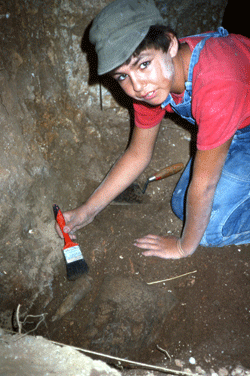
|
After I interviewed Gaby about his discovery
of the silver amulets, he introduced me
to Gordon Franz with whom he had stayed
in contact since 1979. Gordon, then a student
at the Institute of Holy Land Studies, was
a volunteer at Ketef Hinnom, the dig by
St. Andrew’s Church. Gaby appreciated Gordon’s
energy and appointed him to be “area supervisor”
of three junior high Israeli students.
Once Gaby realized the importance of Cave
#25, the youngsters were replaced with adult
volunteers.
In Gordon words, “I caught the ‘bug’ at
Ketef Hinnom in 1979 and have not been cured
from it yet!” Since then, Gordon has
worked at Tel Lachish, Tel Jezreel, Ramat
Rachel, and Khirbet Nisya (Biblical Ai).
Since 2003, Gordon has been bringing groups
from the Associates for Biblical Research
(www.BibleArchaeology.org) to dig at Hatzor.
“I am not an area supervisor,"
says Gordon modestly. “I am |
|
Photo:
Courtesy of Gordon Franz
|
just a donkey pushing wheelbarrows.” |
|
13-year-old Nathan in
1979
|
|
|
|
|
Gordon is especially interested to know
if anyone has seen Nathan, whose youthful
impatience alerted Dr. Gaby Barkay to the
potential of Cave #25. |
|
|
|
12 MOST
POPULAR ARTICLES this month |
|
|
|
Gila
Yudkin, who calls herself a former
Connecticut Yankee living now in King David's
Court, has been guiding since 1978.
She has been taking on-site archeological
seminars with premier archeologist Gaby
Barkay since the 1980s. Gila shares
her up-to-date info with groups and thrives
on showing veteran tour leaders new, authentic,
biblical sites. Give her an opportunity
and your sermons will be enriched and your
colleagues envious.... |
|
|
Coming to
Jerusalem soon?
Are you coming from very far away and
want every minute to matter? Would
you like to experience both the authentic
and the traditional sites, yet you are
most interested in finding the venues
where you can quietly be transported
back in your imagination to the time
of Jesus? David? Abraham?
Make every minute matter while you
"Explore Jerusalem's
Soul" with
Gila's
Unorthodox Guide. This up-to-date
PDF (Adobe Acrobat) 46-page guide gives
you the Top Ten places to meditate on
the Bible, the Top Ten lesser-known
churches worth visiting, the Top Ten
most rewarding roof-top views and the
top Ten places for Middle Eastern food. More
on
Gila's Jerusalem
Guide....
|
|
|
|
Read about the discovery of the Dead Sea
Scrolls in
Shepherds, Scholars and
the Dead Sea Scrolls |
|
|
|
More Biblical Archeology: |
|
|
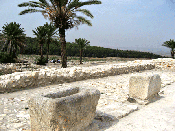 |
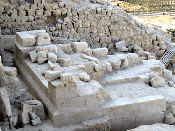 |
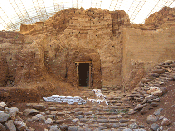 |
|
Mangers at Megiddo |
Herod's Tomb |
Mud-brick gate at
Dan |
|
|
|
|
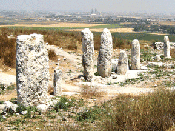 |
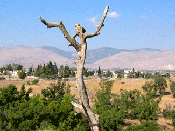 |
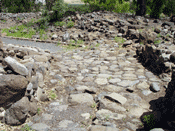 |
|
Gezer & Solomon's
wife |
Tel Beth Shean |
1st C AD street in
Bethsaida |
|
|
|
|
Copyright 2005, 2009 Gila Yudkin. Permission
needed for any reuse. |
|
|
|
GILA
YUDKIN
•
TCHERNIKOVSKI
64A
•
JERUSALEM
•
ISRAEL
gila@itsgila.com
HOME
•
BOOK
GILA
•
TIPS
FOR TOURS •
ABOUT GILA
|
|

